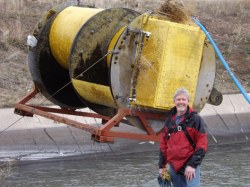
Engineer Jim Styner with the Hydrovolts test turbine.
Canals are ecologically barren channels built for the utilitarian purpose of draining rainwater and snowmelt away from rivers and delivering it to farmers, factories, and homes. But something unusual has been lurking in an irrigation canal in rural Washington that promises to turn these concrete water conveyors into climate-friendly power plants.
A bright yellow turbine resembling a 15-foot roll of Scotch tape was dropped into the gushing waterway near Yakima, Wash., in March to generate cheap, renewable electricity while emitting no carbon.
The experimental hydrokinetic turbine is an archetype of an emerging technology that could quickly become commonplace in the canals that crisscross great swaths of continents.
“There are huge regions of the world that are irrigated, where they have built these highways of water,” said Burt Hamner, founder and CEO of Seattle-based startup company Hydrovolts, which invented and manufactured the prototype turbine. He expects the devices, capable of powering several homes, to sell for $20,000 apiece once they hit the market within the next couple of years. “We’ve found a way to make a little power off it without any environmental impact.”
As water streams down the canal, the turbine spins, which in turn generates electricity — just as breezes spin windmills to create wind energy. The device sits right on the canal’s concrete floor. Hydrovolts’ turbines could also be placed in spillways, water treatment plants, and other places where water flows through a human-made structure free of snags.
President Barack Obama’s administration has been looking at ways to draw more hydropower from underutilized sources like canals and water-storage reservoirs. “Hydrokinetic power is a growing component of the hydropower resources, and it’s one that’s largely untapped in this country,” said Anne Castle, assistant secretary for water and science in the Department of the Interior.
Castle leads the U.S. Bureau of Reclamation, which owns and operates thousands of miles of canals, including the Roza Canal in Washington where the Hydrovolts turbine was installed. The canal is part of a system that delivers Yakima River water to 136,000 acres of Washington farmland.
In April, the bureau released a report detailing how more than 500 of its canals could be tapped to produce new supplies of electricity. The report followed a 2010 memorandum of understanding [PDF] struck between the departments of Interior and Energy and the Army Corps of Engineers to work together to expand hydropower in the United States.
New hydropower projects are moving forward under the strategy. On May 3, for example, a hydroelectric facility was switched on at one of the bureau’s facilities in Oregon, where energy is being generated as water spills down from one canal through a more conventional style of turbine and into another canal.
Hydrokinetic technology is still in its infancy, but one day power produced in the bureau’s canals could reduce the amount of fossil fuels used to pump and manage the water, Castle said. Alternatively, she said the electricity could be sold to constrain operating costs.
First, the bureau wants to see more testing to make sure the turbines do not obstruct water operations or affect water quality. “If something happened with the unit, would it cause failure to the canal?” said Tony Hargroves, the bureau’s water-storage supervisor for the Yakima facility. “These kinds of things are being studied right now.”
The demonstration Hydrovolts turbine has at times generated more than eight kilowatts of electricity, according to Hamner — a modest but meaningful amount of juice that could power a handful of homes. The turbine was recently plucked back out of the water for repairs.
But it’s unlikely that canal-based hydrokinetic devices would become a major power source. “This technology is not for powering towns,” Hamner said. “It’s for powering homes and farms and villages.”
Another company, Boston-based Free Flow Power, has a different vision for hydrokinetic power: It aims to install hundreds of thousands of its larger hydrokinetic turbines in the Mississippi River in order to generate as much electricity as a nuclear plant. The company ran a successful demonstration project using one turbine last year and is working with regulators to plan a larger pilot project.
Hamner, for his part, has a goal of eventually selling hundreds of thousands of Hydrovolts devices throughout the American West, India, Pakistan, China, Australia, Brazil, and other parts of the world where canals abound.
When placed in canals, the turbines might be painted green so they blend in — and also for a more pressing reason.
“We’re told that if it’s a bright yellow,” said Hamner, laughing but deadly serious, “then people will shoot at it.”
Watch installation of the Hydrovolts turbine in Washington — skip through the first 45 seconds to reach the frothing action shots:



